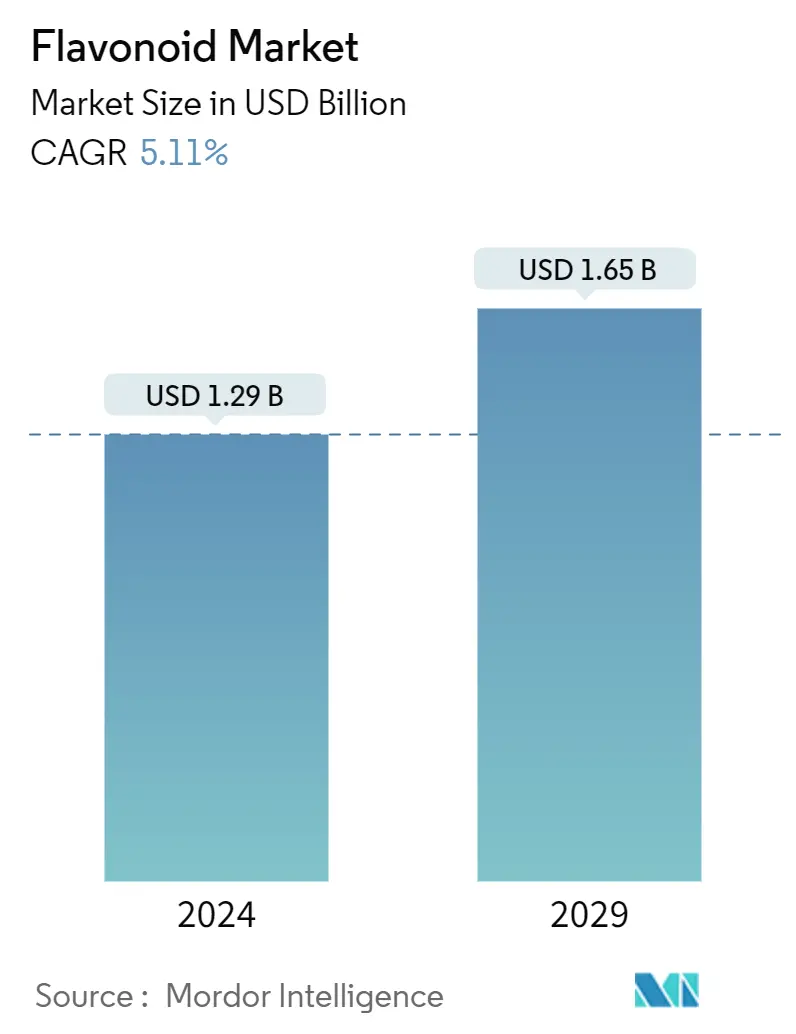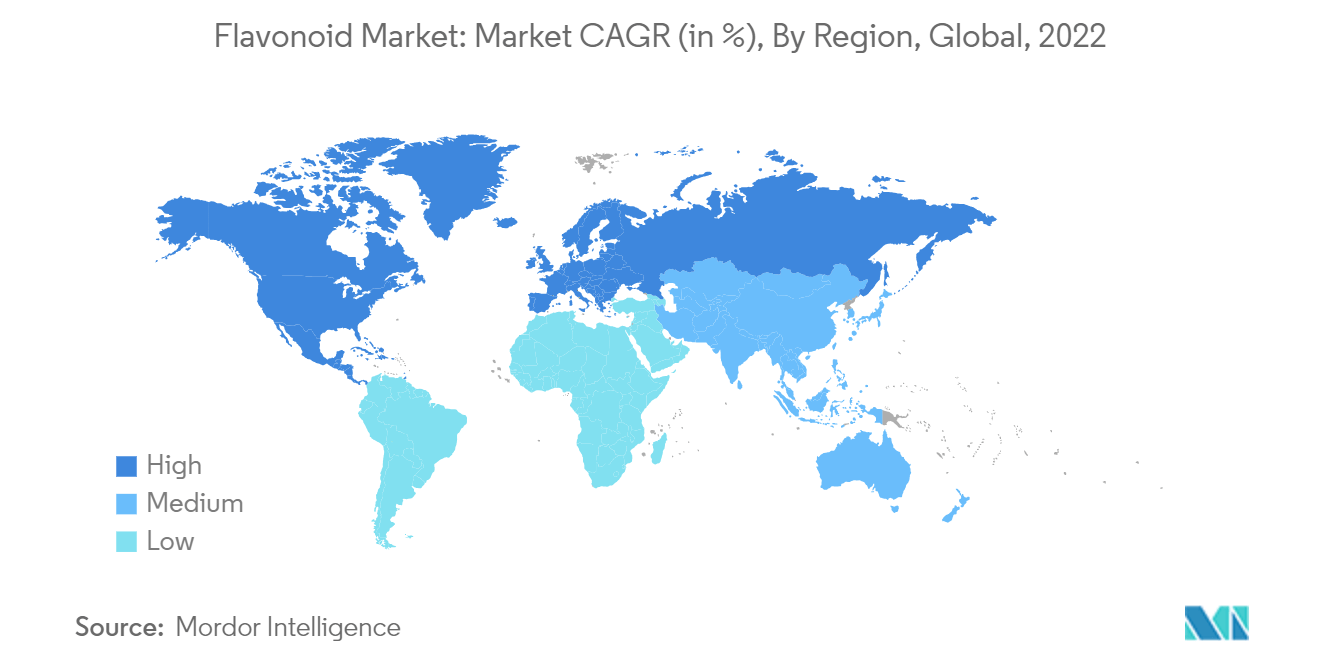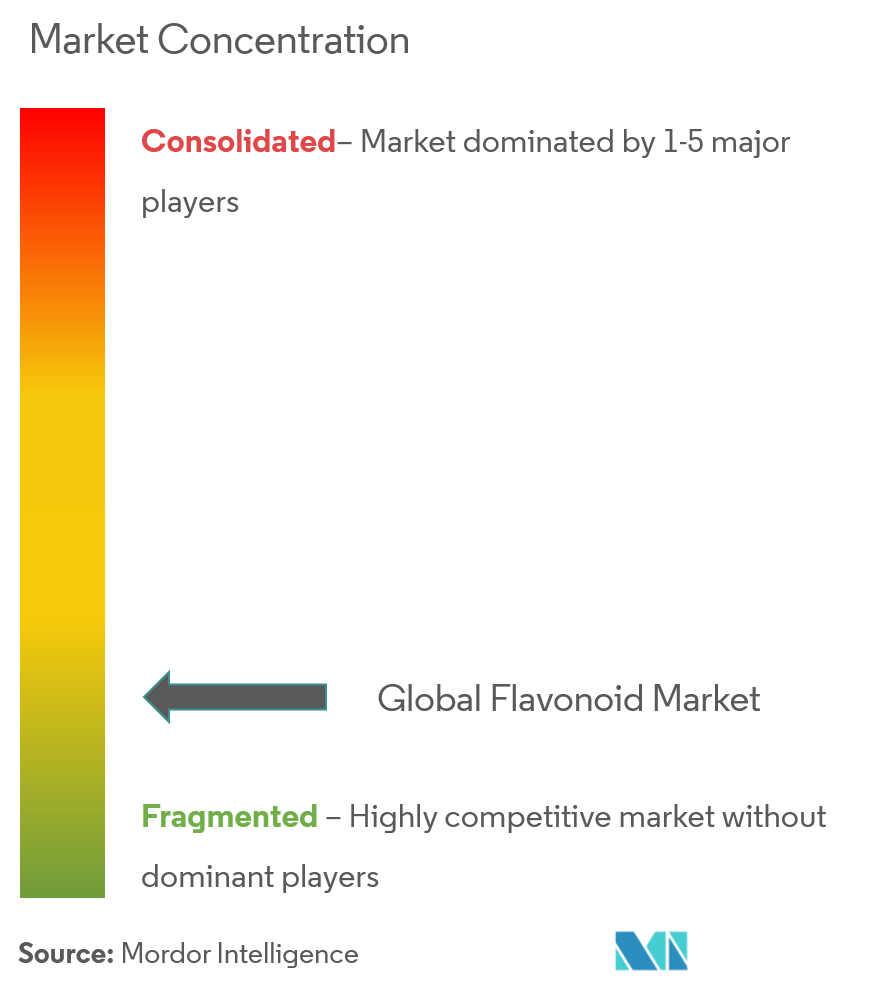Flavonoids Market Size

| Study Period | 2019-2029 |
| Market Size (2024) | USD 1.29 Billion |
| Market Size (2029) | USD 1.65 Billion |
| CAGR (2024 - 2029) | 5.11 % |
| Fastest Growing Market | Asia Pacific |
| Largest Market | North America |
Major Players.webp)
*Disclaimer: Major Players sorted in no particular order |
Flavonoids Market Analysis
The Flavonoid Market size is estimated at USD 1.29 billion in 2024, and is expected to reach USD 1.65 billion by 2029, growing at a CAGR of 5.11% during the forecast period (2024-2029).
Flavonoids are commonly used in cosmetics due to their positive effect on maintaining healthy and young skin. Creams and cosmetic products containing these compounds smooth and moisturize the skin, prevent wrinkles, help collagen synthesis, and protect against UV rays. The growing demand for natural and organic beauty products is driving the market. Moreover, the growing demand for convenience food products has increased the use of flavonoids. The flavonoid market has maintained its growth over the past few years due to its high level of antioxidants and beneficial anti-inflammatory factors.
Additionally, plant flavonoids have potential health benefits, which has led to their being increasingly used in the pharmaceutical and nutraceutical industries. The increased demand for nutraceuticals among consumers is thus driving the global flavonoid market. For instance, in October 2021, Layn Natural Ingredient Corp., Ltd. (Layn Natural Ingredients) announced the expansion of its portfolio of tea extracts. Layn Natural Ingredients expanded its tea extract portfolio in response to increasing consumer demands for clean-label, healthy, functional natural ingredients. Tea extracts contain scientifically supported antioxidants and other active ingredients, including flavonoids and polyphenols. Such innovations and expansions are significant to the growth of the flavonoid market. Changing consumer lifestyles and rising demand for beauty and health supplements are expected to propel flavonoid consumption over the forecast period.
Flavonoids Market Trends
Nutraceutical is the Largest Industry for Flavonoids
The prevalence of heart disorders, cancer, and other diseases is increasing due to the rising consumption of processed and unhealthy food products. Flavonoids act as antioxidants, neutralizing harmful free radicals in the body that can cause cellular damage. They help in reducing oxidative stress, which is linked to various chronic diseases, such as heart disease and cancer. They also possess anti-inflammatory properties that help manage inflammation-related conditions such as arthritis, inflammatory bowel diseases, and certain skin disorders.
Additionally, the demand for gut health supplements is increasing among consumers due to increasing digestion problems; hence, the demand for flavonoids in gut health supplements is also increasing. According to Holland and Barret data from 2023, 58% of people in the United Kingdom suffered from gut health problems. Moreover, flavonoids, such as anthocyanins and anthocyanidins, are also used as colorants in nutraceutical products. The use of natural colorants is increasing due to increased awareness about synthetic ingredients, thereby supporting market growth. According to the United States Food and Drug Administration data, color additives are required to be pre-approved by FDA before their use. Owing to this, the use of natural colorants like anthocyanins is increasing in nutraceuticals.

North America Dominates the Market
The rising concerns about healthy lifestyles have led the population in Canada to cater to dietary supplement or nutraceutical intake. The nutritional food and supplement market is exploding with growing consumer interest in food containing bioactive compounds, such as flavonoids, which aid in preventing several diseases. Although flavonoids have been perceived as promising health-promoting ingredients in different industries, their low bioavailability is a concern as it can limit or even hinder their health effects. Therefore, manufacturers attempt to improve the bioavailability and efficacy of flavonoids. For instance, in February 2022, ingredients manufacturer Taiyo launched its water-soluble quercetin precursor supplement ingredient, IsoQ, in the United States, with a substantially greater bioavailability than free quercetin.
Moreover, consumers in the United States are becoming more health conscious and are opting for the consumption of products with fewer artificial additives. Natural colorants like anthocyanins are widely used in different food and beverage products. Also, the functional benefits of flavonoids like anti-diabetic, anti-inflammatory, anti-aging, antimicrobial, and anti-cancerous benefits are propelling its growth in the country in industries like the healthcare sector, personal care section, and animal feed sector. Additionally, the United States has one of the largest national pharmaceutical industry worldwide. Considering the same, the utilization of flavonoid compounds, particularly genistein catechins, apigenin, and luteolin pharmaceutical products, including the ones targeted for formulations in anti-inflammatory drugs, anti-cancer therapies, oxidative stress reduction drugs, is expected to drive the market significantly during the forecast period.

Flavonoids Industry Overview
The global flavonoid market is competitive with major players, such as Bordas Chinchurreta SA, Cayman Chemical Company, Merck KGaA, Indena S.p.A., and Layn Natural Ingredients. They have an advantage in expanding their product range globally due to advanced distribution networks and manufacturing expertise. Also, these companies are investing in research and development (R&D) and making products with new technologies to expand their presence in the market and retain their position. They are further concentrating on enhancing their product quality to obtain a competitive edge over other players in the market. With increased industry regulation worldwide, the launching of new products, mergers, and acquisitions have also expanded to acquire a vast market share.
Flavonoids Market Leaders
-
Cayman Chemical Company
-
Merck KGaA
-
Indena S.p.A
-
Layn Natural Ingredients
-
Bordas Chinchurreta SA
*Disclaimer: Major Players sorted in no particular order

Flavonoids Market News
- May 2023: Foodchem showcased its food ingredients and additives products in Egypt through the food ingredients exhibition in Cairo. The showcased products include various food additives, including acidulants, acidulants, anti-caking agents, defoamers, antioxidants, bleaching agents, leavening agents, coating agents, colorants, color protectors, compound food additives, emulsifiers, enzyme preparations, flavors and fragrances, flavor enhancers, flour treatment agents, moisture retainers, nutritional fortifiers, preservatives, stabilizers, gelling agents, and sweeteners, etc.
- September 2022: The US-based company Layn Natural Ingredients introduced a natural antioxidant flavonoid called bio+quercetin. The company described the new product as a "highly bioavailable version of quercetin for nutraceutical usage." The flavonoid, derived from Sophora japonica, was designed to help the industry shift to bioavailable products.
- May 2022: Merck expanded its membrane and filtration manufacturing capabilities in Ireland. The company invested approximately EUR 440 million to increase its membrane manufacturing capacity in Carrigtwohill and build a new manufacturing facility at Blarney Business Park in Cork, Ireland.
Flavonoids Market Report - Table of Contents
1. INTRODUCTION
- 1.1 Study Assumptions and Market Definition
- 1.2 Scope of the Study
2. RESEARCH METHODOLOGY
3. EXECUTIVE SUMMARY
4. MARKET DYNAMICS
-
4.1 Market Drivers
- 4.1.1 Awareness and Extensive Promotions for Differentiated Food Ingredients
- 4.1.2 Favorable Regulatory Framework
-
4.2 Market Restraints
- 4.2.1 High Processing Cost and Low Yield of Flavonoids
-
4.3 Porter's Five Forces Analysis
- 4.3.1 Threat of New Entrants
- 4.3.2 Bargaining Power of Buyers/Consumers
- 4.3.3 Bargaining Power of Suppliers
- 4.3.4 Threat of Substitute Products
- 4.3.5 Intensity of Competitive Rivalry
5. MARKET SEGMENTATION
-
5.1 Type
- 5.1.1 Anthocyanin
- 5.1.2 Flavones
- 5.1.3 Flavan-3-ols
- 5.1.4 Flavonol
- 5.1.5 Anthoxanthin
- 5.1.6 Isoflavones
- 5.1.7 Other Types
-
5.2 Application
- 5.2.1 Nutraceutical
- 5.2.2 Pharmaceutical
- 5.2.3 Cosmetics
- 5.2.4 Animal Feed
- 5.2.5 Food Processing
-
5.3 Geography
- 5.3.1 North America
- 5.3.1.1 United States
- 5.3.1.2 Canada
- 5.3.1.3 Mexico
- 5.3.1.4 Rest of Noth America
- 5.3.2 Europe
- 5.3.2.1 Germany
- 5.3.2.2 United Kingdom
- 5.3.2.3 France
- 5.3.2.4 Russia
- 5.3.2.5 Spain
- 5.3.2.6 Italy
- 5.3.2.7 Rest of Europe
- 5.3.3 Asia-Pacific
- 5.3.3.1 India
- 5.3.3.2 China
- 5.3.3.3 Australia
- 5.3.3.4 Japan
- 5.3.3.5 Rest of Asia-Pacific
- 5.3.4 South America
- 5.3.4.1 Brazil
- 5.3.4.2 Argentina
- 5.3.4.3 Rest of South America
- 5.3.5 Middle-East and Africa
- 5.3.5.1 South Africa
- 5.3.5.2 Saudi Arabia
- 5.3.5.3 Rest of Middle-East and Africa
6. COMPETITIVE LANDSCAPE
- 6.1 Strategies Adopted by Leading Players
- 6.2 Market Positioning Analysis
-
6.3 Company Profiles
- 6.3.1 Cayman Chemical Company
- 6.3.2 Foodchem International Corporation
- 6.3.3 Merck KGaA
- 6.3.4 Indena S.p.A.
- 6.3.5 Extrasynthese
- 6.3.6 Indofine Chemical Company
- 6.3.7 Venkatesh Natural Extract Private Limited
- 6.3.8 Layn Natural Ingredients
- 6.3.9 Bioriginal Food & Science Corp
- 6.3.10 Ingredients By Nature
- *List Not Exhaustive
7. MARKET OPPORTUNITIES AND FUTURE TRENDS
** Subject To AvailablityFlavonoids Industry Segmentation
Flavonoids can be defined as a species of polyphenolic lower-level metabolites originating from plants that are consumed as dietary food. The global flavonoid market is segmented by type, application, and geography. By type, the market is segmented into flavanone, anthocyanin, flavan-3-ols, flavonols, anthoxanthin, isoflavones, and other types. Further, the market has been segmented by application into nutraceuticals, pharmaceuticals, cosmetics, food processing, and animal feed. Also, the study provides an analysis of the flavonoids market in emerging and established markets across the world, including North America, Europe, Asia-Pacific, South America, and the Middle East and Africa. The market sizing has been done in value terms in USD for all the abovementioned segments.
| Type | Anthocyanin | |
| Flavones | ||
| Flavan-3-ols | ||
| Flavonol | ||
| Anthoxanthin | ||
| Isoflavones | ||
| Other Types | ||
| Application | Nutraceutical | |
| Pharmaceutical | ||
| Cosmetics | ||
| Animal Feed | ||
| Food Processing | ||
| Geography | North America | United States |
| Canada | ||
| Mexico | ||
| Rest of Noth America | ||
| Geography | Europe | Germany |
| United Kingdom | ||
| France | ||
| Russia | ||
| Spain | ||
| Italy | ||
| Rest of Europe | ||
| Geography | Asia-Pacific | India |
| China | ||
| Australia | ||
| Japan | ||
| Rest of Asia-Pacific | ||
| Geography | South America | Brazil |
| Argentina | ||
| Rest of South America | ||
| Geography | Middle-East and Africa | South Africa |
| Saudi Arabia | ||
| Rest of Middle-East and Africa |
Flavonoids Market Research FAQs
How big is the Flavonoid Market?
The Flavonoid Market size is expected to reach USD 1.29 billion in 2024 and grow at a CAGR of 5.11% to reach USD 1.65 billion by 2029.
What is the current Flavonoid Market size?
In 2024, the Flavonoid Market size is expected to reach USD 1.29 billion.
Who are the key players in Flavonoid Market?
Cayman Chemical Company, Merck KGaA, Indena S.p.A, Layn Natural Ingredients and Bordas Chinchurreta SA are the major companies operating in the Flavonoid Market.
Which is the fastest growing region in Flavonoid Market?
Asia Pacific is estimated to grow at the highest CAGR over the forecast period (2024-2029).
Which region has the biggest share in Flavonoid Market?
In 2024, the North America accounts for the largest market share in Flavonoid Market.
What years does this Flavonoid Market cover, and what was the market size in 2023?
In 2023, the Flavonoid Market size was estimated at USD 1.22 billion. The report covers the Flavonoid Market historical market size for years: 2019, 2020, 2021, 2022 and 2023. The report also forecasts the Flavonoid Market size for years: 2024, 2025, 2026, 2027, 2028 and 2029.
Flavonoids Industry Report
Statistics for the 2024 Flavonoids market share, size and revenue growth rate, created by Mordor Intelligence™ Industry Reports. Flavonoids analysis includes a market forecast outlook 2029 and historical overview. Get a sample of this industry analysis as a free report PDF download.



